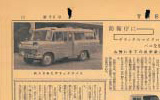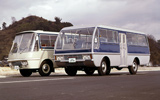
Mazda sold its first bus in February 1960. It was a 13-seat minibus based on the D1500, Mazda's cab-over semi style compact truck, and was sold to the Japan Defence Agency. With the seats folded down, the D1500 could also be used to transport injured soldiers on stretchers. In addition to this convenience, it sported a distinctive design and its comfort levels were on a par with ordinary passenger vehicles of the time. In December 1960, Mazda began exporting the bus to the Middle East, equipped with dual heaters, electrically operated doors and center-opening freestyle doors at the back that enhanced its qualities as an ambulance.
Mazda's first bus for general public use was a 25-seater launched in May 1965, called the Light Bus Type-A. With its innovative "dream car" styling, the Light Bus was an improved version of a concept model that had caused a stir at the 1964 Tokyo Motor Show, and was equipped with a 2-liter engine that delivered 81ps maximum power. The bus featured a huge, curved windshield made from laminated safety glass and head-turning futuristic styling.

D1500 sold to the Defense Agency (source: The Yoko, March 1960)

1965 Light Bus (left: Type-C, right: Type-A)
Evolution to the Parkway 26
On April 17, 1972, in response to demand for upscale minibuses, Mazda launched a fully redesigned minibus dubbed the Parkway 26. Based on the outstanding Titan truck of the period, the bus featured rigid suspension, a range of powerful engines and exceptional economy and reliability as well as safety.
The Parkway 26 had the longest wheelbase in its class at 3,285mm, a wide tread and stabilizers, and its suspension was given optimal spring rates. The engine lineup included a 2.0-liter unit that boosted maximum power from the previous 81ps to 92ps. Two diesel engines were also available: a 2.5-liter unit with 77ps maximum power, and a 2.7-liter version delivering 81ps maximum power. In addition to modern styling similar to passenger cars of the day and comfortable accommodation for 26 passengers, the interior featured a radio and a powerful heating system with 3-stage switching, soft ceiling trim and other refinements that created a spacious, premium ambience.
On July 22, 1974, Mazda introduced the world's first low-emission, rotary engine (13B) minibus, the Parkway Rotary 26. This bus had the exceptional performance and quietness of a rotary vehicle, as well as outstanding environmental efficiency for its day, which cleared Japan's exhaust gas emissions standards at the time by a wide margin.


